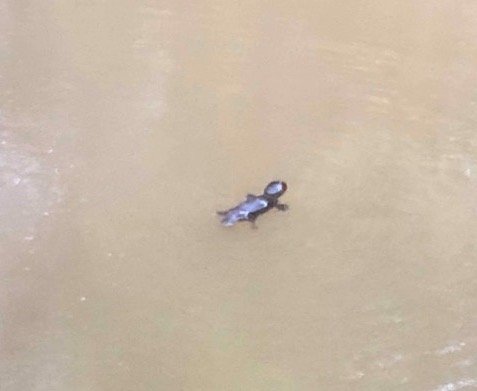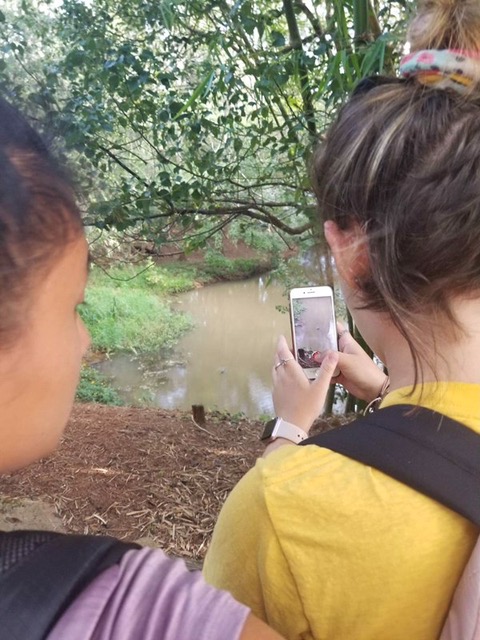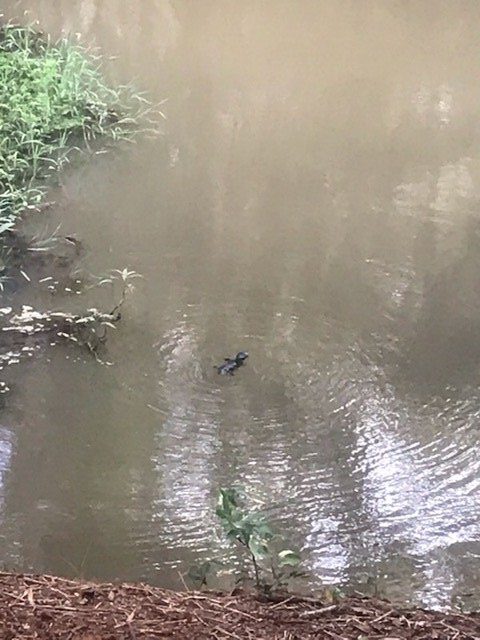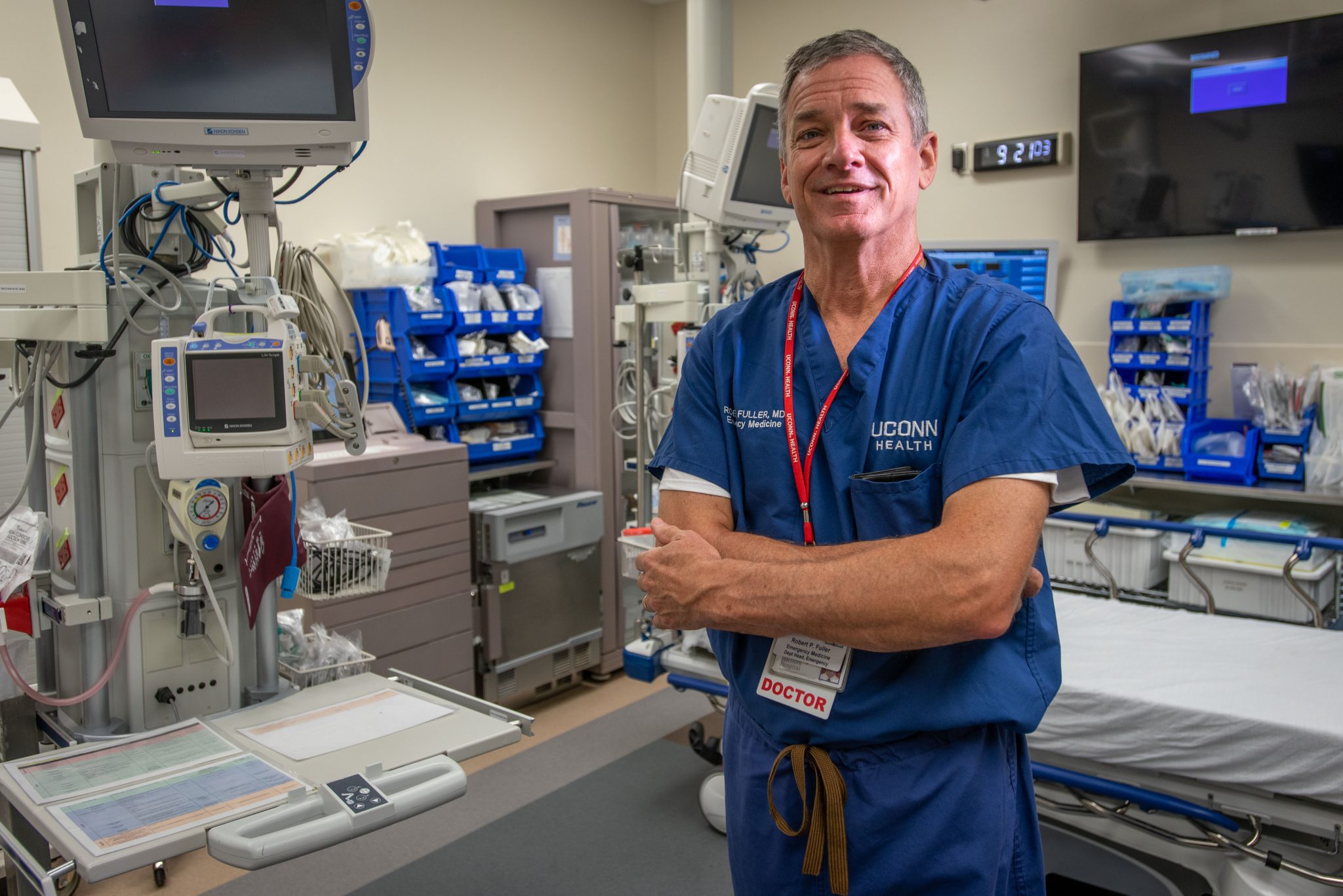How Likely Are You to Spot a Wild Platypus While in Australia?

Audio By Carbonatix

A platypus in Peterson Creek in Yungaburra, Australia. Courtesy photo
An observational study on platypus density in Yungaburra, Australia.
Written and submitted by students in the SIT Australia Rainforest, Reef and Cultural Ecology Program, including Ansley Levine of West Hartford (College of William and Mary), Gaia Bostick (University of Puget Sound), Sarah Orth (California Polytechnic State University), and John McCormack (University of Virginia)

Students observe a platypus in Peterson Creek in Yungaburra, Australia. Courtesy photo
You often hear about the strange yet enticing platypus, but never expect to see this odd creature in the wild.
Australia is known for some of the most alien-like animals in the world, including the platypus; it’s almost extraterrestrial with its duck-like bill, beaver-like tail, and webbed claws.
We recently had the opportunity to survey these mystical creatures in Yungaburra, a small but quaint town in North Queensland, Australia, as part of our study abroad program. The study site was Peterson Creek, which runs through the Atherton Tablelands, an elevated region of North Queensland that includes a combination of rainforest, agricultural land, and beautiful countryside towns. The area is known for a variety of unique species endemic to Australia, like the Lumholtz’s tree kangaroo and Boyd’s forest dragon. The Tablelands also boasts a number of tourist sites from which to observe the mysterious but adorable Australian platypus.
This semi-aquatic mammal, found only in Australia, is one of the few species of egg-laying mammals in the world. Male platypus have spurs on their hind feet that are capable of delivering a strong venom, which is quite rare among mammals. Platypus are also distinctive in that their bills are lined with electroreceptors, which are used to detect the muscle movement of their prey.
Peterson Creek has been subject to changes as Yungaburra has increased its agricultural and tourist-related development. Since the 1900s, much of the land around Peterson Creek has been converted to cattle pasture, buildings, and roads.
In the late 1990s, the path alongside the creek was extended to create a walking trail for tourists to spot the platypus. It is debatable whether or not platypus numbers have declined because of this increase in “platypus tourism.”Although Peterson Creek is located in a suburban area with increasing human development, it might still be a good home for the platypus. The surrounding farmland increases nutrient flow into the creek, which could increase the abundance of the platypus’ invertebrate prey.
So, if you’re interested in finding a platypus, must you venture off into Australia’s dense rainforest, or can you remain in town? Our survey sought to answer whether or not platypus can thrive in a suburban waterway like Peterson Creek. We also aimed to determine the factors that influence platypus numbers so that you’ll be best prepared to catch a glimpse during your trip down under.

A platypus in Peterson Creek in Yungaburra, Australia. Courtesy photo
Platypus are solitary creatures with a low population density, so we conducted a group observational study over a 650 meter stretch of creek to increase our chances of spotting one. We split into 11 pairs, and synced our watches to record the platypus dive times (amount of time spent underwater) and surface times. We also recorded the direction in which they swam to better understand the platypus’ density and use of the creek.
Our findings confirm that you can in fact spot a wild platypus at Peterson Creek! We recorded 17 platypus, though some of the sightings were of the same individual. After reviewing the results, we determined that at least four platypus were living in this stretch of creek. Is this a lot of platypus? Past research suggests it is. A study in Victoria estimated platypus population density at only two individuals per km of stream (Gardner and Serena, 1995). Our results equate to 6 platypus per km of stream.
In considering a trip to Peterson Creek, you might also be interested in the best time of year to view platypus. The dry season, from April to November, is probably your best bet. Past data from Peterson Creek (2017) recorded nine platypus during the dry season. In contrast, our wet season survey recorded only four platypus in this same area, which is consistent with another wet season study that observed only five (2013).
Why is platypus viewing better during the dry season? It might be due to decreased water levels in Lake Tinaroo, the outlet of Peterson Creek. More platypus might move into creeks as the lake’s water level falls during the dry season. In addition, increased flow makes feeding difficult for the platypus (Souter and Williams, 2001), reducing the number of animals willing to venture into the creek. Keep this in mind in planning your viewing!
So you know platypus are in Peterson Creek, and you know to visit during the dry season. But where should you focus your viewing once your here?
An “ideal” platypus habitat has been categorized as a slow flowing river or stream with a complex mix of aquatic vegetation and overhanging foliage (Grant and Smith, 1998). Keep an eye out for platypus burrows as well – we saw three during our survey! These burrows are sometimes visible in the riverbank, just along the water’s edge. If you can spot one, you have a good chance of some consistent platypus action. In addition, make sure to get up early or take a walk at sunset, as it is more likely to see them at these times of day. Lastly, ask the locals, who know where the best sites are!
Though platypus can be seen in Peterson Creek, are they here to stay? We surveyed their foraging habits for further insight. Past research suggests a correlation exists between the duration of platypus’ underwater dives and their foraging success. A lower ratio of dive time to surface time implies more efficient feeding, as the platypus are spending less time searching for food underwater (Kruuk, 1993). We recorded an average ratio of 3.85 to 1, which is much higher than the ratios of past surveys on Peterson Creek.
It seems the platypus this year were having a harder time finding food. This might involve the fact that North Queensland has experienced its first real wet season in many years, possibly leading to a decline in platypus prey (fish, invertebrates, etc). A 1989 study by Garry Scrimgeour suggests flooding does indeed decrease invertebrate populations in rivers. If a steady food supply isn’t present in the creek, there are no guarantees the platypus will remain in the area.
In conclusion, our Peterson Creek survey suggests suburban waterways can be great for platypus viewing. A high density of platypus live in the creek, despite its suburban surroundings – they don’t seem to mind the farms nor the tourists!
So, if you want to see a platypus, we recommend that you avoid the rainy season and go for an evening stroll (or at the crack of dawn, if that’s your thing) in Yungaburra. Just make sure to keep your voices down, avoid rapid motion, and most importantly, bring a camera!
Further Reading
Gardner J.L. and Serena M. 1995. Spatial organization and movement pattern of adult male platypus, Ornithorhynchus anatinus. Australian Journal of Zoology. 43:91-103.
Grant, T. R., and P. D. Temple–Smith. 1998. Field biology of the platypus (Ornithorhynchus anatinus): historical and current perspectives. Philosophical Transactions of the Royal Society B: Biological Sciences. 353:1081–1091.
Kruuk, H. 1993. The Diving Behaviour of the Platypus (Ornithorhynchus anatinus) in Waters with Different Trophic Status. The Journal of Applied Ecology, Vol. 30, No. 4. 592-598.
Scrimgeour, G.J. and Winterbourn, M.J. (1989). Effects of floods on epilithon and benthic macroinvertebrate populations in an unstable New Zealand river. Hydrobiologia.171(1):33-44.
Souter, N.J., and Williams, W.D. 2001. A Comparison of macroinvertebrate communities in three south Australian streams with regard to reintroduction of the platypus. Transactions of the Royal Society of S. Aust. 125(2):71-82.
Previously written, unpublished papers by the 2013 Wet Season and the 2017 Dry Season SIT Rainforest, Reef and Cultural Ecology study abroad group.
Like what you see here? Click here to subscribe to We-Ha’s newsletter so you’ll always be in the know about what’s happening in West Hartford!



